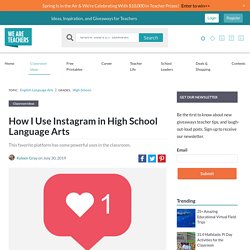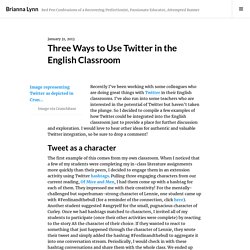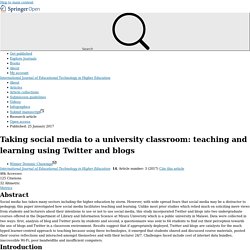

"How I Use Instagram in High School Language Arts" - Gray. Instagram recently surpassed Snapchat as the favorite social media platform for teens.
In this article, high school teacher Kyleen Gray discusses how she uses Instagram to teach her students about the power of theme and make instapoets out of them and more. She says that she uses the platform because it is already one employed by her students and a good way to sneak lessons into their worlds. – bxharris
Like most teachers, reading this statistic compelled an involuntary eye roll, as if I didn’t know my students were glued to their Insta-perfect online lives.

But it also led me to ask a question: How could I infiltrate my students’ Insta-world with sneaky lessons and learning opportunities? I started with creating a school Instagram account and went from there. What I learned was that Instagram doesn’t have to be our classroom enemy; we can easily make it our ally. Check out these five easy Instagram-based language arts lessons and assignments to add some digital engagement to your LA classroom. 1. Last year, while using my school Instagram account, I took a short video of a student who was sharing a book they read and asked them to post it as well.
The first step is to have them analyze the Instagram accounts of famous people, places, or businesses for evidence of purposely constructed theme(s). "Malvern teacher uses TikTok to meet students where they are, gains 147K followers" MALVERN, Ark.
This video from Arkansas news affiliate KATV interviews a middle school English instructor has created micro-lessons on TikTok to reach students remote learning during the pandemic. Ultimately, this highlights the benefits of utilizing global technologies to reach students beyond the immediate classroom to reach students where they are. – bxharris
(KATV) — It’s no secret that between virtual learning and in-classroom instruction, keeping student’s attention through the pandemic has been a struggle for most teachers.

That’s why a Malvern Middle School English language arts teacher is meeting students where they already are. Claudine James teaches eighth grade in Malvern. Her classes are in-person, but when her students were in quarantine she, like most teachers, struggled to keep them engaged. James was posting her lessons to YouTube, but quickly realized it wasn’t working. “I looked at my YouTube counter and it didn't move, I mean, the YouTube thing said zero views,” James said. When her students came back to the classroom, she asked if they were watching her videos. “That day, I just sat down with my students and made a TikTock account, and I asked them about, you know how to do it, I didn't know how to do anything,” she said.
The account started in December, and by her third day, James was up to 10,000 followers. "The Twitter Experiment". "Three Ways to Use Twitter in the English Classroom" - Lynn. Recently I’ve been working with some colleagues who are doing great things with Twitter in their English classrooms.
While offering three possible uses for Twitter in English classes, Lynn focuses more on one of my favorite activities: using social media as a means of getting students into a character's head. In the article she describes an activity where students need to compose a tweet from the perspective of a character from Shakespeare's MacBeth. This activity allows students to consider other viewpoints and practice thinking like others, but the activity itself is infinitely flexible. It can be used with any text and on any platform. – bxharris
I’ve also run into some teachers who are interested in the potential of Twitter but haven’t taken the plunge.

"Teaching with Twitter" - Hedge. Stephanie Hedge is a graduate student in the Department of English at Ball State University.

You can follow her on twitter at @slhedge. The last several semesters, I have been incorporating Twitter into my teaching style and lessons, and it has quickly become an inextricable part of my teaching tool box. "#Hashtags in the Writing Classroom" – Tham. Hashtags are used to group messages and label topics.
Tham discusses the various effective uses for hashtags in college writing classes. One of his suggestions deals with language shift. He argues that being aware of how hashtags are being used--particularly their use as a form of commentary--can help us teach digital-age writing students. – bxharris
Today, hashtags are widely used in the social networks as a markup for groups of interests that belong together and a language for expression that is used outside the traditional sentence structure.

Steve Boyd in a blogpost describes hashtags as “twitter groupings” that can be “wonderful for serendipity.” Hashtags are to Twitter as Likes are to Facebook, until Facebook stole the light recently by launching its own hashtagging function. Read about the origin of Twitter hashtags here. How do #Hashtags work? By simply writing the pound symbol (#) in front of a keyword or a phrase (written as one word), e.g. For example: Failure is inevitable. Due to its searchable nature, hashtags allow trending topics/terms to be featured in your social networks. Using #Hashtags in writing instruction Writing instructors may take advantage of the functions hashtags offer to help students engage with public conversations as they learn to write. "Social Presence and Identity: Facebook in an English Language Classroom" - Vanek, King, and Bigelow.
This article covers a study conducted at the University of Minnesota with a class of ESOL students who were primarily Somali refugees. The study examined the way that language acquisition and confidence were impacted when students were asked to use Facebook as part of the class structure and design. Overall, researchers found that, through their interactions on Facebook, students received positive reinforcement from their peers, felt safer writing more complex uses of English, and that the increase in more complex language use carried over into classroom work as well. This article raises real promise about the efficacy of using social media for language acquisition and use, as it puts students in an environment that is more inline with their everyday lives. – bxharris
"Flipping the Switch: Code-Switching from Text Speech to Standard English" - Hawley Turner. "An Academic Use for Social Media" - Alrubail. If we look at digital literacy and its implementation in the classroom for the past 10 years, we can see the impact on students’ writing and communication skills. In an online survey by the Pew Research Center on the impact of digital tools on students’ writing, half the teachers who responded said that digital tools made it easier for students to write and that when using digital tools, students were more engaged and motivated to write. "Taking social media to a university classroom: teaching and learning using Twitter and blogs" Ajjan, H., & Hartshorne, R. (2008).

Investigating faculty decisions to adopt Web 2.0 technologies: Theory and empirical tests. The Internet and Higher Education, 11(2), 71–80.Article Google Scholar Azab, A. N., Abdelsalam, M., & Gamal, S. (2013). Use of Web 2.0 collaboration technologies in Egyptian public universities: An exploratory study. Accessed 20 Aug 2013.Barczyk, C.